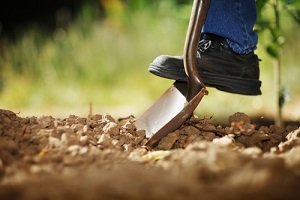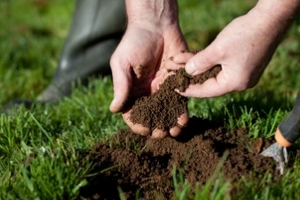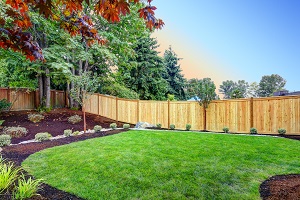 One of the most exciting aspects of an inground pool removal is preparing your new yard. There are so many ways you can enjoy this newfound space, whether you want to create an area for children and pets to play, or you are interested in using it for entertaining and relaxing. Many of these uses begin with a grassy space, so the first step you should take is planting grass seeds.
One of the most exciting aspects of an inground pool removal is preparing your new yard. There are so many ways you can enjoy this newfound space, whether you want to create an area for children and pets to play, or you are interested in using it for entertaining and relaxing. Many of these uses begin with a grassy space, so the first step you should take is planting grass seeds.
It is much easier to grow grass after a pool full removal compared to a fill-in. In a partial removal, the concrete that remains can cause the ground to shift or shrink, which creates sinkholes.
However, if you get a full inground pool removal, your contractors should leave the yard in good condition for planting grass. They will likely fill in the area with dirt and compact and smooth it, leaving you with a flat surface on which you can plant your grass.
Planting grass is a relatively straightforward process. Here is a look at steps involved in growing grass after your inground pool removal.
1. Choose The Right Grass Seed
You will want to choose the right type of grass for your location as well as your budget and lifestyle. Consider whether your lawn is going to get full sun or partial sun. It is also important to keep in mind how your yard will be used; yards that get a lot of foot traffic or are used by pets need hardier grass.
2. Get Your Timing Right
It is important that you plant your grass seed during the right time of year. If you are looking to plant a cool season grass, the ideal planting time is in spring or early fall. These seeds may not establish in summer or winter, and any new grass that grows may not survive extreme temperatures. However, if you are planting warm season grasses, aim for early summer as these seeds need to be planted in warm soil to germinate.
3. Consider Testing Your Soil
 Although this is not necessary, you may want to test your soil to increase your chances of grass planting success. You can obtain a soil test kit and check the pH; the ideal pH for most types of grass is between 6.0 and 7.0.
Although this is not necessary, you may want to test your soil to increase your chances of grass planting success. You can obtain a soil test kit and check the pH; the ideal pH for most types of grass is between 6.0 and 7.0.
Soils that are too acidic, with a pH under 6, can be rectified by mixing ground limestone into the soil, while soil that is too alkaline, with a pH over 7, can be brought back into balance by adding compost, sulfur or composted manure.
4. Get Your Soil Ready For Planting
Look over the area where you plan to plant your grass seed before you start. It is likely that your inground pool removal contractors have left the yard in good condition, but it is a good idea to look for any large rocks or debris that could get in the way of your grass and fill in any low spots.
Your pool removal contractor likely compacted the soil, and you may wish to work over it with a tiller as pea-sized particles are best for planting grass seed. If you spot any uneven areas in your yard, a garden rake should be enough to even it out.
5. Add Your Grass Seeds
Next, it is time to add your grass seeds. Spread them across the soil and ensure they are distributed evenly. A poor distribution of seeds could cause your grass to grow in unsightly clumps with bare spots. If you are concerned about getting a good distribution, consider using a seed broadcaster to help.
At this point, you might want to consider feeding the lawn with fertilizer, ensuring that the type you intend to use is suitable for application at seeding time. However, you will want to be careful not to over-fertilize your seeds.
Then, you can use a turf roller to press the grass and flatten out the surface. This can help the seeds bury properly beneath the soil. Alternatively, you could consider covering your grass seed with a thin layer of soil to help keep it from drying out or washing away. There are some types of soil that are created specifically for this purpose. If there are any hills in your yard, you will need to mulch it with a thin layer of straw to keep the seeds from washing away.
6. Pay Attention To Watering
A newly seeded lawn needs regular watering using a garden hose or a sprinkler system. However, like anything else you might grow, it is important to strike the right balance between proper hydration and oversaturation. You will want to keep the top inch of soil consistently moist, but make sure it does not feel soggy. If it is hot and dry, you may need to mist your seeded area more than once a day. Be sure to use a very light water stream so you do not drown your seeds.
After your seeds have begun to germinate, you will want to try to keep the top 2 inches of soil moist until the grass has grown roughly 3 inches tall, which is considered mowing height. After that, you may only need to water your lawn about twice a week, but you will want to soak the soil several inches deep every time to encourage your grass roots to take hold deep within the soil.
Adding Beauty And Functionality To Your Yard After Pool Removal
 Grass is only the first step to getting the yard of your dreams following an inground pool removal. Once your grass has reached mowing height, it is time to add other features that lend beauty and functionality to the space. You might consider installing a fire pit, building a patio, getting an outdoor hot tub, building an outdoor kitchen or creating a gardening area in your yard.
Grass is only the first step to getting the yard of your dreams following an inground pool removal. Once your grass has reached mowing height, it is time to add other features that lend beauty and functionality to the space. You might consider installing a fire pit, building a patio, getting an outdoor hot tub, building an outdoor kitchen or creating a gardening area in your yard.
When you remove an inground pool and set up a beautiful green space in your backyard, you have a whole world of options open to you when it comes to how you can use the space for family enjoyment.
Get In Touch With The Inground Pool Removal Professionals
If you are considering having your swimming pool removed, reach out to the Northern Virginia pool removal experts at Dirt Connections. Known for professional pool removal services and impeccable backfilling and yard grading, they can also help with many common post-removal projects.
Summary

Dirt Connections was started with one goal in mind: providing quality residential and commercial construction services to clients on time and on budget. Reach out for more information on how we can support your next project.
For your convenience our estimates are free and by appointment. Call 703-940-9949 for a free estimate today!









































